 |
 |
 |
I know most of you aren’t paying attention, but you should be.
If Concrete Revolutio were a song, I think it would be The Monkees “Shades of Grey”…
When the world and I were young,
Just yesterday.
Life was such a simple game,
A child could play.
It was easy then to tell right from wrong.
Easy then to tell weak from strong.
When a man should stand and fight,
Or just go along.
But today there is no day or night
Today there is no dark or light.
Today there is no black or white,
Only shades of gray.
I remember when the answers seemed so clear
We had never lived with doubt or tasted fear.
It was easy then to tell truth from lies
Selling out from compromise
Who to love and who to hate,
The foolish from the wise.
But today there is no day or night
Today there is no dark or light.
Today there is no black or white,
Only shades of gray.
It was easy then to know what was fair
When to keep and when to share.
How much to protect your heart
And how much to care.
But today there is no day or night
Today there is no dark or light.
Today there is no black or white,
Only shades of gray.
Only shades of gray.
That song (written by husband-and-wife Barry Mann and Cynthia Weil, who had almost 100 songs chart in the USA) was about the disillusionment in the dying days of the protest movement of the 1960’s – a time when counterculture was beginning to seem more truly represented by Altamont than Woodstock. And I think that’s entirely fitting for Concrete Revolutio, a series that’s not just focused on shades of grey (Jirou openly acknowledged such this week), but very much mindful of the sour aftertaste the violent university protests in Japan left in the mouths of idealists (who’ve since been an endangered species in Japan, at least publicly).
I have a theory about this show and its somewhat scattershot narrative style. If indeed it’s two split cours (which is widely believed though not officially confirmed as far as I can tell) perhaps this first cour is all about setting the stage – establishing the rules of the game and who the players are (and perhaps most importantly, how they chose sides). Effectively, this cour would be the prequel, with the second depicting the final struggle – and in doing so, adopting a traditional linear narrative style. I have no hard evidence to back that up, but it would make a certain amount of sense.
Whether or not that’s going to be the case, Concrete Revolutio for now continues its herky-jerky antics – this episode alone jumped between Year 38, 42 and 47. And it introduced a couple more tropes to the pot – we had a boys’ detective agency (with a couple of girls, despite the “Shounen” and “BL” in the name). And that agency also brought super sentai mecha gattai into the mix too, with its “Gigander” giant robot – a function of its superhuman leader’s ability to manipulate metal.
That leader is Otonshi Yumihiko (Murase Ayumu), who we briefly met back in Episode 4 – though his real name is Daitetsu Maki. That’s crucial, because Daitetsu was one of a group of superpowered children kidnapped in Year 38 by Rainbow Knight – a superhero figure Jirou (and many others) deeply idolized, but who supposedly died in disgrace after the kidnapping incident. That incident deeply impacted Daitetsu/Otonoshi and drove him to his current vocation, and it seem to have deeply impacted Jirou too. Also of import is the talk of the “Eye of Lucifer” – an arch-criminal whom Daitetsu impersonates as part of BL Clan’s most recent job.
This is definitely “can’t tell the players without a scorecard” territory – the story is intentionally confusing and lots of misdirection is happening here. Do the other members of BL Clan know about Otonoshi’s past and his true motives? When we flash forward to Year 47 (which seems to be “the present”) we know Jirou and Earth-chan (and Judas) oppose the Superhuman Bureau, and Daitetsu and his new mecha Rex FE (“Iron King”) – but is Daitetsu working with the Bureau, or as a separate interest?
One thing’s for sure – we’re very lucky to have two takes on the superhero genre as smart and complex as One Punch Man and Concrete Revolutio airing simultaneously. And it’s never been more clear that the focus of this series is the grey area between good and evil, and the hunger of adults to regain the moral certainty they had as children. The Rainbow Knight is only the latest element to play into that theme, but one of the most unmistakable – indeed, if we’re getting clarity in any sense it’s in CR openly acknowledging its core themes in these last few weeks. This show is a fascinating puzzle that refuses to show us what its completed form looks like, but I’m happy to keep piecing it together.
 |
 |
 |
 |
 |
 |
 |
 |
 |
 |
 |
 |
 |
 |
 |
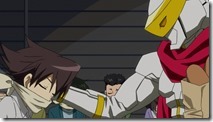 |
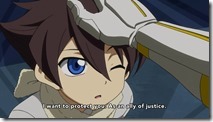 |
 |
 |
 |
 |
 |
 |
 |
 |
 |
 |



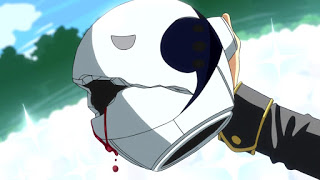
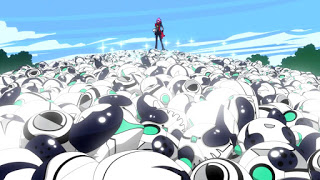
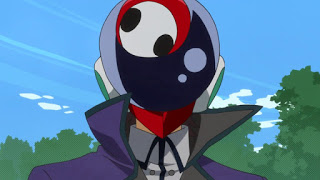

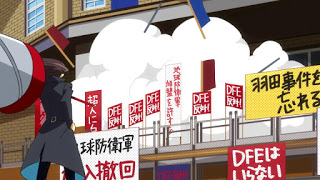
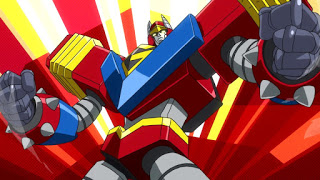


Gary Cochran
November 23, 2015 at 1:08 amI'm guessing the other members of BL are also kidnapped kids. There were quite a few there bound and gagged when Rainbow Knight brought them food.
Booshwashna
November 23, 2015 at 7:54 pm"but very much mindful of the sour aftertaste the violent university protests in Japan left in the mouths of idealists (who've since been an endangered species in Japan, at least publicly)."
This might be stupid, but do you mean protesters or idealists?
admin
November 23, 2015 at 9:40 pmIdealists, sadly.
Booshwashna
November 24, 2015 at 8:48 amThat's fascinating to me. Would you mind explaining a little how that affects the present day populace? I love anime, but any window into understanding the people better that will illuminate the stories I watch into greater relief is tantalizing.